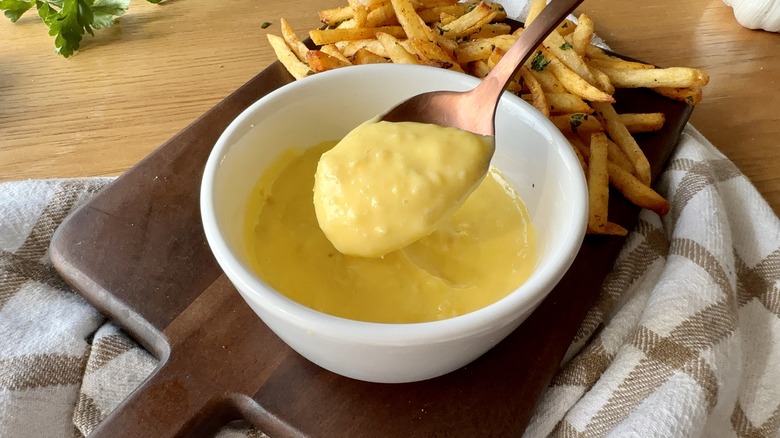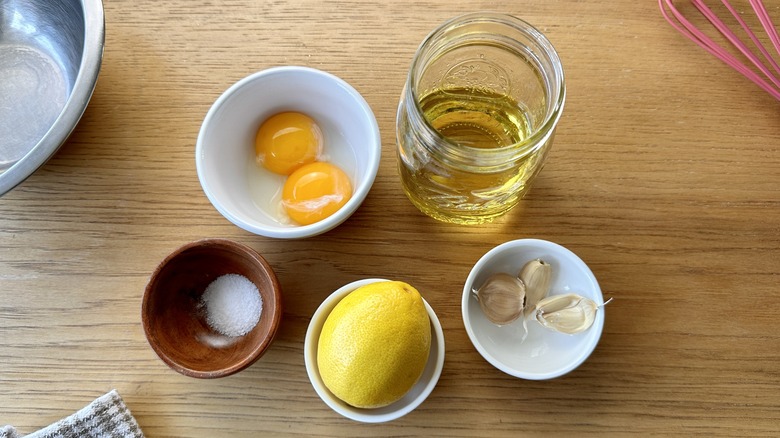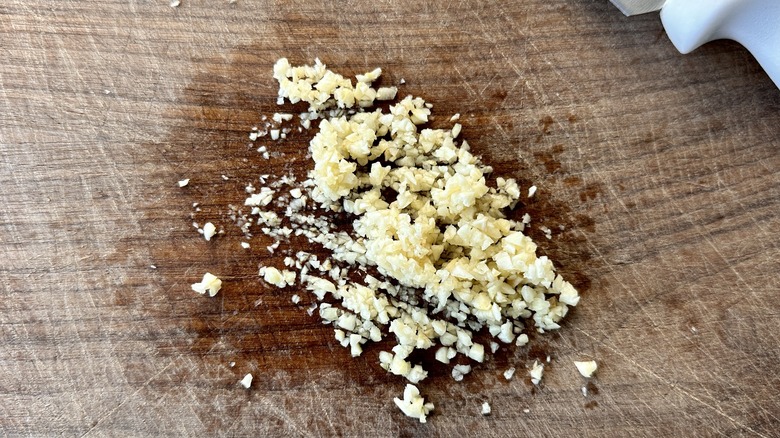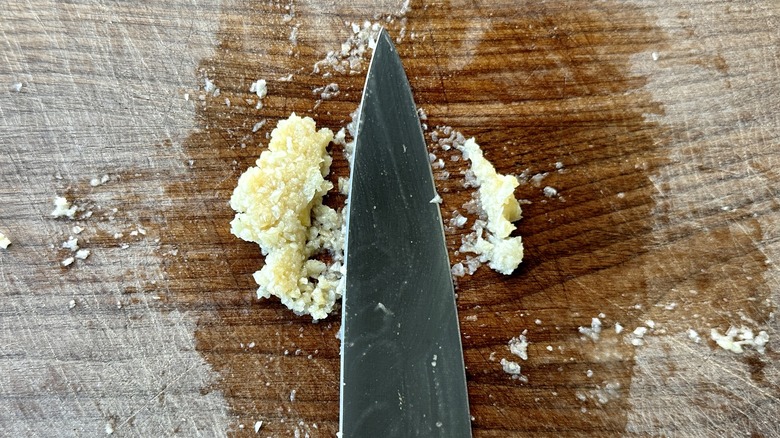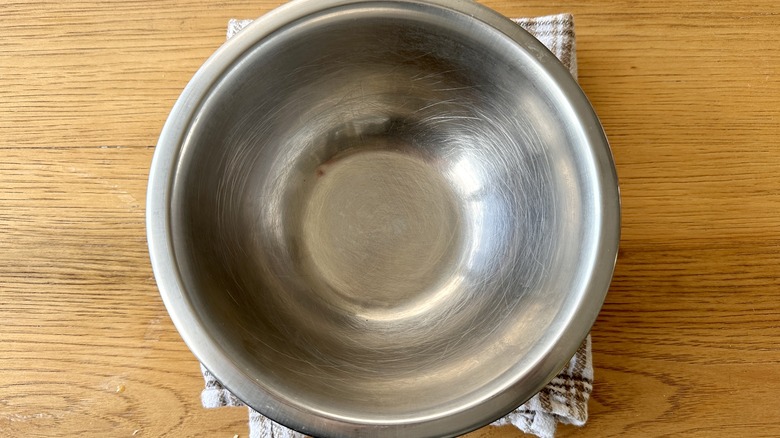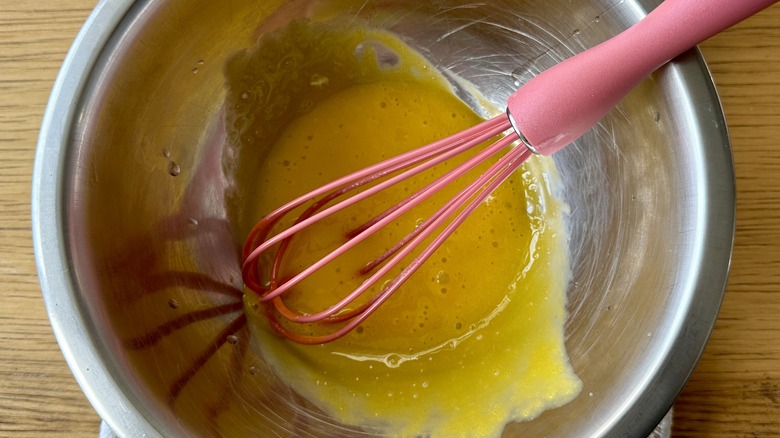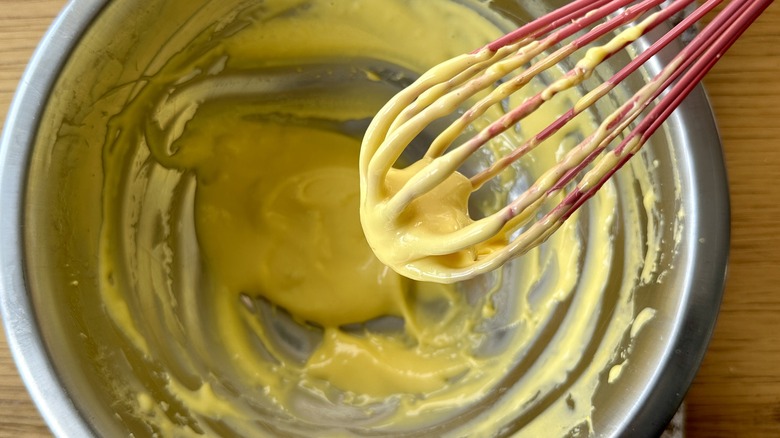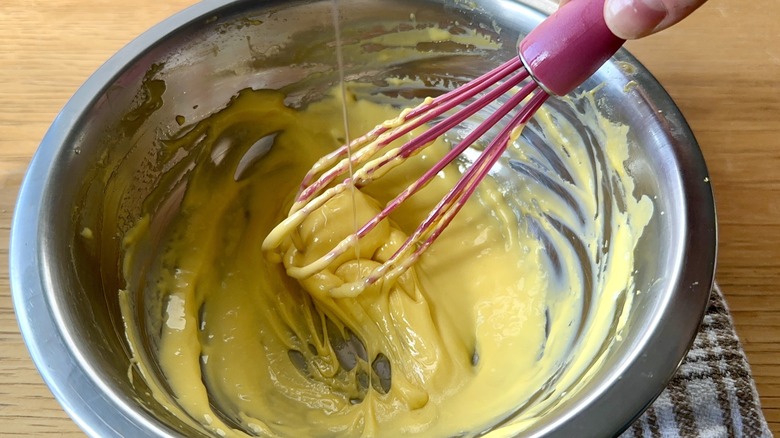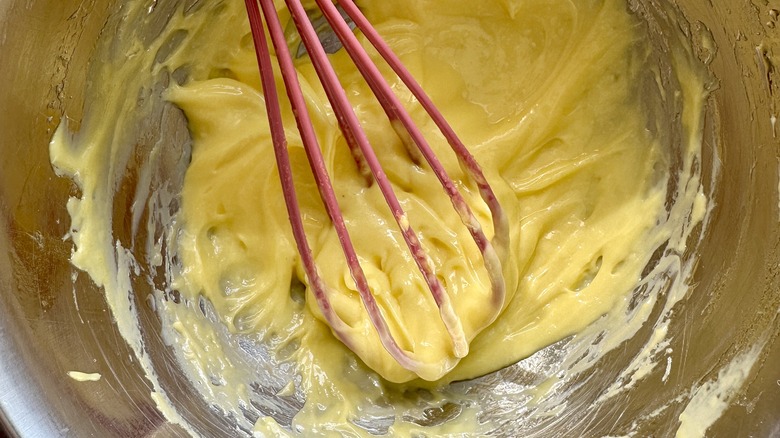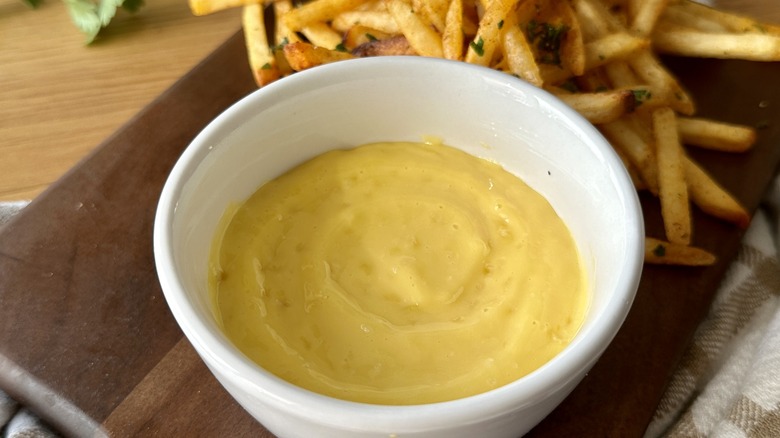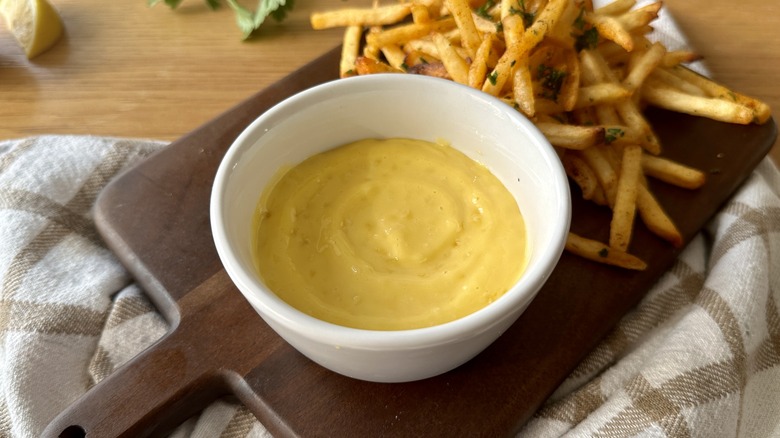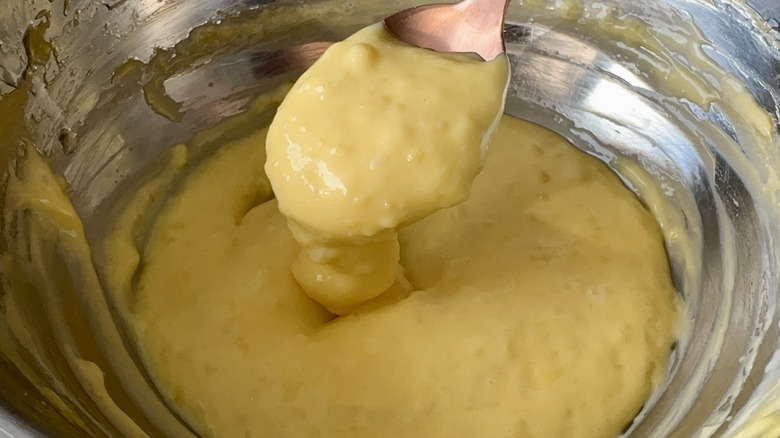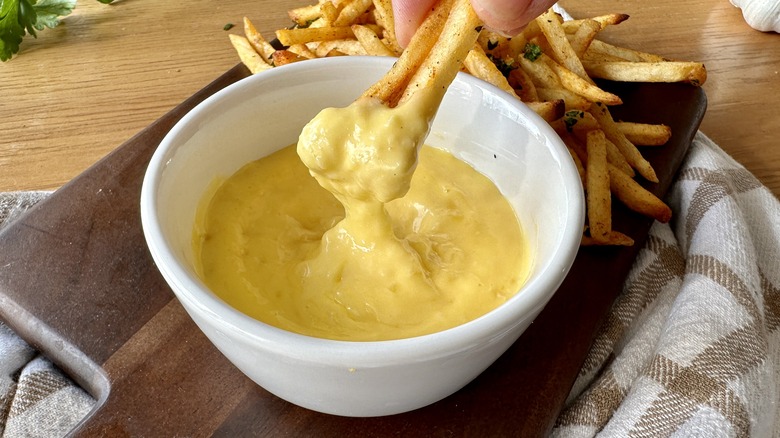Standard Homemade Aioli Recipe
If you love garlic, you'll love aioli. The word aioli, breaking down into "ai" for garlic, and "oli" for oil in Catalan and Provencal languages, is traditionally an emulsified paste of garlic and oil, with modern-day recipes often including egg yolks for even more richness. While the origin is unclear, aioli has been used as a dip for centuries. It most likely originated in ancient times in the Mediterranean or Egypt, later popularized in southern France or eastern Spain. Today, you'll find aioli on plenty of menus, either layered into sandwiches, served with French fries, drizzled over tacos, and more.
Recipe developer Katie Rosenhouse says, "Aioli is one of those classic components that makes any dish better. The texture is so creamy and rich, and the flavor, depending on what you add to it, can be garlic-heavy, spicy, or herbaceous. It's the perfect fatty complement to any protein, side dish, sandwich, and so much more."
Gather the ingredients for standard homemade aioli
Aioli can be as simple as an emulsion of garlic and oil, but for this recipe, we include egg yolks to help bind the mixture together for a rich, creamy texture. For 2 egg yolks, we add 3 cloves of garlic. It might seem like a lot, but trust us — aioli that's light on the garlic just isn't aioli. Lemon juice adds fresh acidity to balance the fattiness of the mixture, and salt balances the overall flavor.
If you're looking to get creative with flavorings, consider adding spices, finely chopped herbs, horseradish, mustard, Sriracha, or anything else you love. "When it comes to aioli, nailing the foundation is the hardest part. Once the emulsion comes together, you can start to really have fun with flavorings. There's nothing more impressive than serving an array of homemade aiolis," Rosenhouse says, "and no one will realize how simple they were to throw together."
Step 1: Mince the garlic
Peel and mince the garlic.
Step 2: Create a paste
Add salt and use your knife to mash the garlic against the cutting board with the salt to create a paste (as smooth as you like).
Step 3: Place towel under bowl
Place a damp towel beneath a medium bowl to secure it.
Step 4: Whisk yolks
Add the yolks to the bowl and whisk until smooth.
Step 5: Whisk in oil
Add 1 teaspoon of oil and whisk to emulsify.
Step 6: Continue adding oil
Continue to add oil in a slow and steady stream, whisking until the oil has been added and the mixture is thick and creamy.
Step 7: Add lemon and garlic
Whisk in the lemon juice and garlic mixture.
Step 8: Transfer to serving bowl
Transfer to a serving bowl or refrigerate in an airtight container for up to 3 days.
Is aioli just garlic mayonnaise?
In the United States, "aioli" and "mayonnaise" are often used interchangeably to describe the same condiment — a creamy dip or spread made with an emulsion of egg yolks and oil. In modern-day restaurants, any flavored mayonnaise tends to be labeled as an aioli (talk about salesmanship) with garlic, Sriracha, lemon, and other flavors becoming popular to serve with a variety of dishes, from French fries to sandwiches.
Classically, the two are different. Mayonnaise is made by slowly whisking oil into egg yolks, adding an acid like lemon juice or vinegar, and salt to flavor the mixture. Traditional aioli is made by crushing garlic using a mortar and pestle, with olive oil added slowly to emulsify the mixture for a creamy result. Egg yolks are often added to enhance the richness of the mixture, as they are in this recipe, for a more modern variation.
Is it safe to eat raw eggs in aioli?
When it comes to cooking with raw eggs, it's important to consider who you're serving. Consuming raw eggs isn't recommended for infants, the elderly, people with weakened immune systems, or pregnant women, but for most of us, it may come down to weighing the risks. Let's face it: the world would be just a little less delicious without egg yolks. From Caesar salad dressing to hollandaise, some of the best and most revered dishes contain raw egg yolks. Jammy eggs on toast ... come on!
On the other hand, a healthy fear of foodborne illnesses is pretty sensible. Infected chickens or cross-contamination during processing can cause salmonella, both on the exterior and interior of an egg. Refrigeration and handwashing can help minimize the risk, but unfortunately, mayonnaise and aioli are at the top of the list of egg-based foods linked to salmonellosis. What are the odds you ask? Well, the CDC estimates that 1 in every 20,000 eggs is contaminated, so, that choice is up to you.
Want to play it safe? You can temper your egg yolks over a double boiler, or purchase pasteurized eggs to use instead, substituting the 2 egg yolks with 1 whole egg if preferred.
What do I serve with aioli?
Aioli can be used in an infinite number of ways, and in fact, we can't think of a meal it wouldn't improve. Whether served as a dip, spread, or sauce, the creamy richness perfectly complements proteins, cheeses, starches, vegetables, and more. The ultimate combination of course, if you're team aioli vs. ketchup, is to pair it with French fries. But don't stop there.
Spread aioli onto sandwiches or hamburgers, or thin with a little extra lemon juice and drizzle over tacos, fish, or lamb. Use it as a dip for crisp vegetables, particularly if serving a crudité platter. It can also traditionally be stirred into seafood-based soups or stews. For movie night, serve with homemade chicken tenders or wings, and keep the leftovers for stirring up into a quick chicken salad for lunch. "The best way to get your family to eat their vegetables is by pairing a sheet pan of roasted veggies with a bowl of aioli," Rosenhouse says. "You'll never see veggies move quicker."
Standard Homemade Aioli Recipe
Traditionally, aioli can be an emulsion of garlic and oil. In this recipe, as is common, we add egg yolks to bind the mixture for a richer, creamy texture.
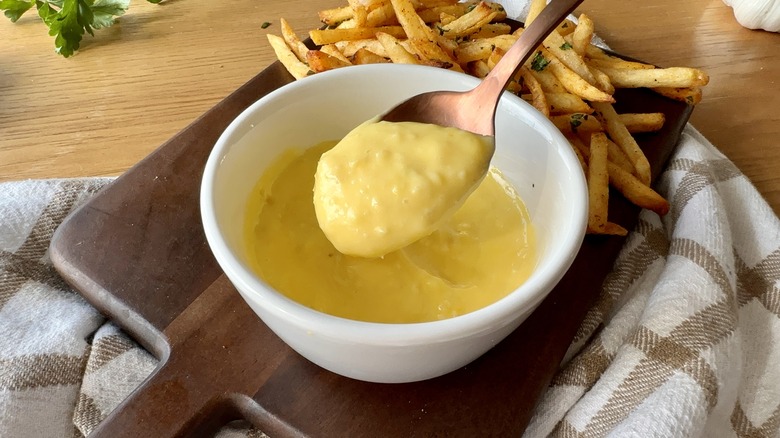
Ingredients
- 3 garlic cloves
- ¼ teaspoon kosher salt
- 2 large egg yolks
- ⅔ cup neutral oil
- 1 ½ teaspoons lemon juice
Directions
- Peel and mince the garlic.
- Add salt and use your knife to mash the garlic against the cutting board with the salt to create a paste (as smooth as you like).
- Place a damp towel beneath a medium bowl.
- Add the yolks to the bowl and whisk until smooth.
- Add 1 teaspoon of oil and whisk to emulsify.
- Continue to add the oil in a slow and steady stream, whisking until the oil has been added and the mixture is thick and creamy.
- Whisk in the lemon juice and garlic mixture.
- Transfer to a serving bowl or refrigerate in an airtight container for up to 3 days.
Nutrition
| Calories per Serving | 352 |
| Total Fat | 38.6 g |
| Saturated Fat | 3.5 g |
| Trans Fat | 0.1 g |
| Cholesterol | 91.8 mg |
| Total Carbohydrates | 1.2 g |
| Dietary Fiber | 0.1 g |
| Total Sugars | 0.1 g |
| Sodium | 113.9 mg |
| Protein | 1.5 g |
